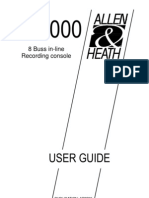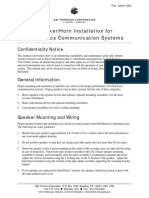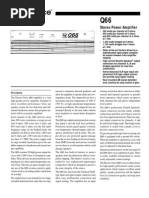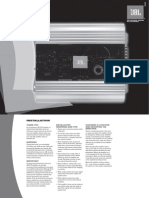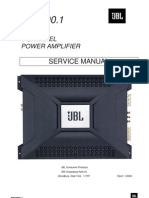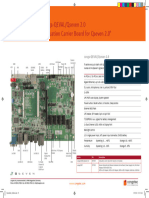Amplificador JBL GTH400
Amplificador JBL GTH400
Uploaded by
Nuno_Alexandre_LopesCopyright:
Available Formats
Amplificador JBL GTH400
Amplificador JBL GTH400
Uploaded by
Nuno_Alexandre_LopesOriginal Title
Copyright
Available Formats
Share this document
Did you find this document useful?
Is this content inappropriate?
Copyright:
Available Formats
Amplificador JBL GTH400
Amplificador JBL GTH400
Uploaded by
Nuno_Alexandre_LopesCopyright:
Available Formats
GTH400-20107
06/03/98 15:49
Side 26
GTH400-20107
06/03/98 15:49
Side 1
GTH400 6/5/4/3 CHANNEL AUTOMOTIVE POWER AMPLIFIER OWNERS MANUAL
GTH400
GTH400-20107
06/03/98 15:49
Side 2
Table of Contents
1. Introduction...................................................................................... 3 1.1 Features .................................................................................... 4 1.2 About Installation ...................................................................... 4 2. Installation and use .......................................................................... 5 3. System Design with the GTH400..................................................... 6 3.1 Speaker Requirements ............................................................. 6 3.2 Typical Applications.................................................................. 7 4. Installation and Use ......................................................................... 9 4.1 Controls and Connectors.......................................................... 9 4.2 Internal Adjustments ................................................................ 12 Speaker-Level Input Impedance Adjustments......................... 12 Crossover Frequency Adjustments.......................................... 12 Custom Chip construction....................................................... 13 Remote Chassis Installation .................................................... 13 Unter-Dash Remote Installation............................................... 14 In-Dash remote Installation...................................................... 14 Power Supply Connections ..................................................... 14 Simultaneous Speaker Stereo-Mono Connection Diagram..... 16 Speaker-Level Input Harness - Color Codes........................... 17 5. Adjusting the Gain .......................................................................... 17 6. Important Characteristics ............................................................... 19 7. In Case of Difficulty......................................................................... 21 8. Specifications ................................................................................. 23
Owners Warranty Information
Model Number Serial Number Dealer Name City, State, Zip Sales Receipt Number Date of Purchase
GTH400-20107
06/03/98 15:49
Side 3
1. Introduction
Thanks for purchasing your new GT series automotive multichannel amplifier. Your GT series amplifier will easily connect to virtually any car audio system, whether it is factory installed or one purchased separately. The GTH400 includes an abundance of unique features which are described in this manual. The most obvious feature of the GTH400 is its 6-channel, staggered-power design. This design provides the simplicity of driving an entire system with a single amplifier without compromise. The flexible design of the GTH400s built-in crossover circuitry also allows elaborate systems to be built more simply than with conventional components. For optimum performance, the power amplifier circuitry is a fully discrete design notable for its low distortion and unusually clean and clear sound quality.
In addition to conventional preamplevel inputs, the GTH400 features JBLs Universal Interface design, which facilitates simple connection to factory radios with the low distortion that is usually only associated with preamp level connection. In addition, when using a high-powered (BTL) radio through the speaker-level inputs, Common Sense turn-on circuitry senses the common-mode voltage present on the radios speaker wires, turning the amplifier on without an additional remote wire.
GTH400-20107
06/03/98 15:49
Side 4
1.1 Features Theory of Operation Virtual Center Image Enhancer JBLs breakthrough Virtual Center circuitry is the result of the understanding of how the human ear responds to timing, frequency, and amplitude cues to determine the apparent direction of a sound source. Virtual Center circuitry manipulates the analog signal in real time to provide each of the drivers ears with the signal they would receive if the driver was seated in the center of the vehicle. This provides a stable, centered image to the driver much like that obtained with a dedicated center-channel loudspeaker. To restore the spaciousness that is generally lost in the small confines of a car interior, the rear channels utilize differential-mode ambience recovery to restore the ambience information present in all conventional stereo recordings. Unlike DSP, the JBL circuitry does not add synthetic reverb, but recovers real information that is masked in conventional systems. As a result, the overall effect from the Virtual Center circuitry of the GTH400 is incredibly realistic, yet simple to adjust and use. Best of all, the Virtual Center and ambiance recovery circuits do not require specially encoded recordings and work with virtually all conventional stereo tapes, discs, and broadcasts.
1.2 About Installation Although the GTH400 is designed to make installation as easy as possible, it is an extremely sophisticated product that requires proper installation and setup to realize its full performance potential. If you feel you do not have the necessary knowledge and skills, we strongly recommend that the installation be done by your authorized JBL dealer. If you choose to install the GTH400 yourself, read all of the information in this manual before you start the installation. Pay particular attention to the safety precautions and notes.
GTH400-20107
06/03/98 15:49
Side 5
2. Installation and use
Refer to the Crossover Frequency Adjustments and Speaker-Level Input Impedance Adjustments sections of this manual to see if you will need to make alterations to their factory settings. 1. Disconnect the negative cable from the battery. Note: If the vehicles radio features a code type security system, make certain you know the code before disconnecting the battery! 2. Run a minimum AWG #8 power cable complete with a 60 amp fuse (not included) directly from the positive +12V battery terminal to the desired amplifier location. Keep the fuse within 6" of the battery terminal, and position it before the wire runs through any metal partition. 3. Note: All wiring connections should be made either by soldering with heatshrink tubing insulation or with high quality crimp-type insulated connectors installed with a professional-type, articulated crimping tool. Soldering crimp-type terminals is recommended for additional security. Never use wire nuts, insulation-displacement connectors (i.e. ScotchLok type), or twist and tape connections. Do not use electrical tape; it will loosen with age and extreme temperatures. 4. Mount amplifier in the desired location using the included screws. 5. Connect power wiring as shown in the Wiring Diagram on page 18.
6. Connect the outputs from the head unit to the appropriate inputs of the amplifier according to the Wiring Diagram (page 18) with either (or both) high quality low-level signal cables with RCA plugs, or the supplied speaker-level input connector. 7. Install the remote control in the desired location. Connect and run the cable from the remote to the amplifier. 8. Connect the speakers to the amplifier according to the Wiring Diagram on page 18. 9. Turn the gain controls to the 1/4-position for all groups. 10. Set the bass boost of each group to the desired position. 11. Set the crossover switches for each group as desired. 12. Set the Group 2 Input and Group 3 Input as desired. 13. Set the mode switches to Stereo, Left + Right, or Left Input Only operation for each group. 14. Double-check your switch settings. Reconnect the negative battery cable. Note: Incorrect switch settings can damage your speakers! 15. Turn on the signal source at a low volume level, and check for the correct output from each speaker. 16. Adjust the amplifier gain controls using the procedure described in the Adjusting the Gain section (page 25). 17. Read the rest of the manual to get maximum use and enjoyment from your amplifier.
GTH400-20107
06/03/98 15:49
Side 6
3. System Design Using the GTH400
3.1 Speaker Requirements When used in the non-bridged mode a group-channel of the GTH400 can easily drive two 2-ohm speaker loads. When only one speaker is connected to the left and right outputs of a group, virtually any conventional speaker may be used. When two speakers are connected in parallel to a single output (left or right) of a given group, each speaker must have a minimum impedance of at least 4 ohms. This ensures that the combined load will not drop below 2 ohms. Although the amplifier will not be damaged, load impedances lower than 2 ohms will eventually cause the amplifier to overheat, activating the protection circuits and causing the unit to shut off until it cools down sufficiently.
Parallel Wiring
When a group of the GTH400 is in bridged mode, the combined impedance of the speaker (or speakers) connected to the bridged channels should be at least 4 ohms. As in the example above, sustained operation of the GTH400 in bridged mode with less than 4 ohms will likely cause overheating. The GTH400 must not be used with speakers that have either one of their input terminals wired to the frame of the speaker or to the chassis of the vehicle.
(+)
2 ohms Nominal Impedance
4 ohms
4 ohms
()
Series Wiring
(+)
8 ohms Nominal Impedance
4 ohms
()
6
4 ohms
GTH400-20107
06/03/98 15:49
Side 7
3.2 Typical Applications The diagrams on pages 8 & 9 show the most common basic system configurations of the GTH400. One or more of these building blocks may be combined to form elaborate system designs.
The GTH400 uses the terminology Group 1, Group 2 and Group 3 to indicate the three main signal paths within the amplifier. Each group may consist of a mono bridged signal or a stereo pair of L+R signals depending on the system configuration.
Application 1
6-Channel Bi-Amplified System with Non-Fading Subwoofers
Group 1 Stereo High Pass Group 2 Group 3 Stereo Stereo GR 2 GR 1+2 High Pass Low Pass
L R L R Preamp or Front Speaker-Level Rear L R
GR 1
Input
L R
GR 2
Mode Group 2 Input Group 3 Input Speaker Crossover Preamp Crossover
GTH400
GR 1 GR 2
L+ R
L R+
L+ R
L R+
L+ R
GR 3
R+
+ R
Front Speakers
+ R
Rear Speakers
+ R
Subwoofers
Application 2
5-Channel Bi-Amplified System with Non-Fading Mono Subwoofer
Group 1 Stereo High Pass Group 2 Group 3 Stereo L+R GR 2 GR 1+2 High Pass Low Pass GTH400
GR 1 GR 2 GR 3
L R L R Preamp or Front Speaker-Level Rear L R
GR 1
Input
Mode Group 2 Input Group 3 Input Speaker Crossover Preamp Crossover
L R
GR 2
L+ R
L R+
L+ R R+
R+
+ R
Front Speakers
+ R
Rear Speakers
Subwoofer
Satellite Speakers
GTH400-20107
06/03/98 15:49
Side 8
Application 3
4-Channel Full-Range or Bi-Amplified
L
Preamp or Speaker-Level Input
R L
4-Channel Full-Range
Input Mode Group 2 Input Group 3 Input Speaker Crossover Preamp Output Crossover Group 1 L Flat Group 2 L GR 2 Flat Group 3 Stereo GR 3 Flat
Front L
GR 1
R Rear L R
GR 3
GR 2
GTH400
GR 1 GR 2 GR 3
4-Channel Bi-Amplified with Fading Mono Subwoofers
Input Mode Group 2 Input Group 3 Input Speaker Crossover Preamp Crossover Group 1 L High Pass Group 2 Group 3 L L+R GR 2 GR 3 High Pass Low Pass
R+
R+
L+ R
R+
+ R
Rear Speakers or Subwoofer
*Stereo subwoofers may also be used by selecting ST on the group 3 input mode switch. Note: Image Enhancement cannot be used in these applications.
Front Speakers
Application 4
3-Channel Bi-Amplified 4-Channel Input (Fading Subwoofer)
Group 1 Input Mode L Group 2 Input Group 3 Input Speaker Crossover High Pass Preamp Output Crossover Group 2 Group 3 L L+R GR 2 GR 3 High Pass Low Pass GTH400
GR 1 GR 2 GR 3
L R Front L
GR 1
L R Rear L
GR 2
L
GR 3
Use these when 4-channel output is available.
2-Channel Input (Mono Subwoofer)
Group 1 Group 2 Group 3 Input Mode L L L+R Group 2 Input GR 2 Group 3 Input GR 1+2 Speaker Crossover High Pass High Pass Low Pass Preamp Crossover Note: Image Enhancement cannot be used in these applications.
R+
R+
R+
R
Main Speakers Subwoofer
GTH400-20107
06/03/98 15:49
Side 9
4. Installation and Use
4.1 Controls and Connectors 1. Preamp-Level Input Connector Use these connectors for line (preamp) level inputs to the amplifier. 2. Preamp-Level Output Connector Use these outputs to send signal to additional amplifiers. 3. Speaker-Level Input Connector Use this connector for speaker level input signals. A wire harness is supplied for use with this connector. See Audio Input Connections section (page 23) for wiring instructions. This input also includes JBLs Common Sense input circuitry which turns the amplifier on as soon as the high powered head unit connected to this input is turned on. 4. Speaker Output Connectors Connect speaker wiring to these connectors. See wiring directions for more information. 5., 6., 7., 8. Power Connector Connection for power wires. See wiring directions for information on proper connections. 9. Fuses Two 30 Amp ATC type fuses.
10. Gain Controls Use these controls to adjust the gain of the amplifier channel group. See the Adjusting the Gain section (on page 25) for tips on proper setup. 11. Preamp Crossover Switches These switches control the built-in crossovers that are directed to the preamp-output connectors. Set the switch to F (flat) for full-band operation for that group. Set the switch to L (low) to activate the lowpass filter on the pre-amp output group (for subwoofer use or to use in conjunction with a high-pass filtered input signal to create a bandpass crossover for a midrange or midbass driver). Set the switch to High-Pass to activate the high-pass filter for use with satellite speakers or tweeters on the pre-amp output group. 12. Speaker Crossover Switches These switches control the built-in crossovers that are connected to each group's power amplifier circuitry. Set the switch to F (flat) for full band operation on a group. Set this switch to L (low) to activate the low-pass filter on the selected amplifier group for subwoofer use or
GTH400-20107
06/03/98 15:49
Side 10
to use in conjunction with a highpass filtered input signal to create a bandpass crossover (for a midrange or midbass driver). Set the switch to H (high) to activate the high-pass filter for use with satellite speakers or tweeters on an amplifier group. 13. Mode Switches These switches are used to set the input mode for both preamp and speaker-level inputs. Set the switch to ST(ereo) for normal operation on the group using individual left and right inputs. Set this switch to L to drive both the left and right outputs with only a single input on the left jack. Set the switch to L+R to sum the left and right inputs for a mono output on the group. These switches do not affect the preamp outputs. 14. Bass EQ Switch These switches activate a built-in Bass Boost circuit used to increase low-bass output on the selected group. These switches do not effect the preamp outputs. 15. Group 2 Input Switch This switch is used to select which inputs will drive Group 2 of the amplifier. Put the switch in position GR 1 to allow Group 2 to be driven by the Group 1 inputs. Put the switch in the GR 2 position to drive Group 2 with the Group 2 inputs. 16. Group 3 Input Switch This switch is used to select which inputs will drive Group 3 of the amplifier. Put the switch in position GR 3 to allow Group 3 to be driven by the Group 3 inputs. Put the switch in the GR 2 position to drive Group 3 with the Group 2 inputs. Put this switch in the GR 1+ 2 position to drive Group 3 with the sum of Group 1 and 2 for a
non-fading subwoofer output on Group 3. 17. Remote Bypass/On Indicator This indicator is on when the Imaging Enhancer is engaged and off when the Imaging Enhancer is bypassed. 18. Driver/All Optimizer Indicator This indicator is on when the Virtual Center Channel circuitry is in Driver optimization mode and off when it is in the All passenger mode. Note: The enhancer on indicator must be on before drivers mode can enabled. 19. Front Ambience Control and On/Bypass Switch Rotating this control adjusts the amount of ambience and front staging width produced by the Imaging Enhancer. Pulling the knob places the Imaging Enhancer in Bypass mode. Pushing in the knob places the Imaging Enhancer in On mode. 20. Rear Ambience and Driver/All Optimizer Control Rotating this knob controls the amount of rear-fill ambience and the room size of the acoustic environment when used in a system with rear speakers. Pulling the knob out places the Imaging Enhancer in All passengers optimization mode. Pushing the knob in places the unit in Driver optimization mode. Best results at the drivers position will be achieved with the control in the Driver setting.
IMAGING ENHANCER
17 19
ENHANCER ON
FRONT AMBIENCE
ENHANCER ON
DRIVER MODE
REAR AMBIENCE
DRIVER
18 20
BYPASS
ALL
MIN
MAX
MIN
MAX
Power Indicator LED (on amp chassis top) LED steadily illuminates for normal operation. LED blinks when protection circuitry or muting is engaged.
10
GTH400 Block Diagram
GR 1 MODE SWITCH
GTH400-20107
CH. 1 L IN
CH. 1 R IN
CH. 2 L IN
CH. 2 R IN IMAGE ENH.
1 1 1 2 3
CH. 1 L OUT
CH. 1 R OUT CH. 2 L OUT
Preamp-level inputs LP X-OVER
3 2
L Buffer Buffer
BASS BOOST HP +
CH. 2 R OUT
2
AMP
1 2 3
GR 1 Left Speaker Out
GR 1
1
AMP
GR 1 L PREOUT
3
Buffer
LP X-OVER
1 2 3 3
HP GR 1 R PREOUT
1 2 3 1 1 2 3 2
GR 1 Right Speaker Out
R Buffer
2
06/03/98 15:49
L Buffer
1 2 1 2 3
LP X-OVER
3 3 3 2 1 2 1 1
GR 2
+ HP
Buffer
AMP
GR 2 Left Speaker Out
R
LP X-OVER
3 2 3 1 2 1
GROUP 2 INPUT 1 GR 1 2 GR 2
Buffer
2 3
BASS BOOST
Buffer
GR 2 L PREOUT
Side 11
AMP
GR 2 Right Speaker Out
L Buffer
GR 2 MODE SWITCH HP GR 2 R PREOUT
1 2 3
GR 3
1 2 3
AMP
GR 3 Left Speaker Out
2
R
LP X-OVER Speaker-level inputs + + HP
1 2 3 1 2 3 1
Buffer
1 2 3
Buffer
GR 3 L PREOUT
L Buffer
LP X-OVER HP Speaker Preamp GROUP 3 INPUT 1 GR 3 2 GR 2 3 GR 1+2 +
1 2 3 1 2 3
Buffer
GR 3 R PREOUT
2 3
BASS BOOST
AMP
GR 3 Right Speaker Out GR 3 Input Mode
GR 1
+
R
1 Flat 2 Low Pass 3 High Pass
Buffer
Crossover
Crossover
1 Flat 2 Low Pass 3 High Pass
Mode
1L 2 Stereo 3 L+R
L Buffer
-
GR 2
+
R
-
Buffer
11
GTH400-20107
06/03/98 15:49
Side 12
4.2 Internal Adjustments Speaker-Level Input Impedance Adjustments The speaker level inputs of the GTH400 come factory set with 100k ohm input impedance. This will provide the lowest distortion operation from the speaker outputs of most modern head units by reducing the power the amplifier in the head unit must deliver to practically nothing. On some older, or lower-priced head units, this load will not facilitate proper fader operation. To allow for this, we have provided the ability to change the input impedance of the speaker-level inputs to 15 ohms. This is accomplished by moving the jumpers
JUMPER SELECTOR SELECT 100K OR 15 OHMS
rotary-type control, not one controlled by electronic pushbuttons. If you are not certain of the type of fader control your unit has, measure the resistance across one set of speaker outputs with an ohmmeter (with the head-unit off). Adjust the fader control through its entire adjustment range. If there is a change in the resistance as the control is adjusted, set the jumpers to the 15-ohm position. (See step 1, page 16 to remove bottom cover.) Crossover Frequency Adjustments The GTH400 amplifiers include built-in frequency selectable crossovers. One crossover is connected in series with the amplifier circuitry and the other crossover is connected to the preamp level output jacks. These crossovers can be set in either the F (full bandwidth operation), L (subwoofer operation), or H (satellite operation). The crossover frequencies are set by chips inside the amplifier. These chips are simply a set of resistors, connected across the pins and molded into a single package. The crossover frequencies may be changed to any value desired by changing the resistor network. Frequency Resistor Value 50Hz 47k 80Hz 33k 120Hz 22k 200Hz 12k 250Hz 10k 375Hz 6.8k 500Hz 4.7k 650Hz 3.9k 2.5kHz 1k 5kHz 470 JBL Part Number 1-23-750 1-23-817 1-23-820 1-23-821 1-23-810 1-23-822 1-23-815 1-23-823 1-23-824 1-23-816
150H 100K R KE MS EA T CE SP INPUDAN OR 150H PE CT IM SELE MS 100K
MS
100K
150H
MS
shown on the diagram above. This input is also capable of directly accepting signals, when in the 100k ohm setting, from many Balanced Line Drivers such as those sometimes used in competition vehicles. For best results, a Balanced Line Driver capable of at least 4V nominal output should be used. If the head unit has 4 channels of builtin amplification and/or an electronic fader control, you should leave the jumpers in the factory set position. If the head unit has 2 channels of amplification, with a speaker-level fader, the jumpers should be set to the 15-ohm position. This will always be a
12
OU
100K
PR
EA
MP
150H
LINE
INPU
GTH400-20107
06/03/98 15:49
Side 13
Custom Chip Construction Regardless of whether you build or buy it, the necessary resistor network has the following configuration:
1. Remove the screws from the bottom panel as shown below.
Each resistor in the package has the same value. If you know the crossover frequency you want, you can calculate the resistor value necessary by solving the following equation: Resistor Value in ohms = 2,500,000 Frequency in Hz
2. Select which resistor module, high pass or low pass, that you wish to change. 3. A chip puller, which can be obtained from any electronics store, is recommended to remove the resistor chip. Pull the resistor chip from the socket as shown in the figure below.
CR OS SO VE R
Use the following equation if you have a resistor pack of a known value, and want to find its crossover frequency: Frequency = in Hz 2,500,000 Resistor Value in ohms
To build chips from discrete resistors, solder the resistors to a standard 14pin DIP Header according to the diagram. If a DIP Header is not available, you may bend the leads of 1 4 -watt resistors 90 degrees, trim them to 18"-length, and insert them directly into the chip sockets. To change the crossover frequency change the resistor network as follows:
4. Place the new module in the socket making sure all pins are lined up with the socket holes. Press the module firmly into the socket. 5. Replace the bottom lid. For further information on how to use the speaker output and preamp output crossovers for system building see the Typical Applications and Add-On and Upgrade Steps sections. Remote Chassis Installation The wired remote of the GTH400 can be installed either in dash or under dash.
HIG H FR FILT PAS SE EQU ER S C LE E MO CT NCY 13 DU ION LE
C10
FR FILT PAS SE EQU ER S LE E MO CT NCY DU ION LE
LO W
NO JB RT L JB HR INC. PC L GTIDGE 00 S6 , C RE 1088 00 A V A 00
13
GTH400-20107
06/03/98 15:49
Side 14
Under-Dash Remote Installation 1. Set the GTH400 remote in the installation location and mark two mounting screw hole locations. 2. Set the GTH400 remote aside and drill two pilot holes using a 116"(1mm) bit. Be careful not to drill into any of the cars components. 3. Secure the spacer and faceplate (with the control labeling) to the front of the remote control panel using the four smaller screws included. 4. Push the two adjustment knobs onto the metal shafts. 5. Set the GTH400 remote back in place and secure it using two sheet metal screws. Continue to Step 6 in the In-Dash Installation section. In-Dash Remote Installation 1. Choose a location for the in-dash installation and use the template at the back of this manual to mark hole locations as shown on the template. 2. Drill the holes indicated on the template. 3. Using the diagram on page 15 as reference, install the remote behind the panel with the holes just drilled. Position the remote so the two knobs feed through panel and the LEDs are in alignment with the holes drilled. 4. Place the trim panel with the control labeling over the two shafts and secure it in place with the 4 screws provided. 5. Push the two adjustment knobs onto the metal shafts. 6. Connect one end of the GTH400
remote control wire (included) to the connector on the back of the remote control box. 7. Run the wire back to the GTH400 main chassis and plug the remote control wire into the Remote In connector on the main chassis. Note: a standard 6-pin telephone extension cord may be used if more wire is needed for remote control connection. These extension cords can be purchased at many electronics or hardware stores. In countries with Right Hand Drive vehicles, the built-in Image Enhancer will not operate properly with standard wiring. To use the GTH400 with right hand drive vehicles, reverse both the input and output wiring as shown below.
Front Speakers Subwoofers Rear Speakers
GTH400
L+
+
R+ L R
GTH400 Audio Signal Connection for Right Hand Drive Cars
+ + + + + L R L R
R R+ R R+ L L+ L L+
Rear
Front L R R L R L
GR 1
L R Group 2
GR 2
The right and left inputs and outputs of the GTH400 must be reversed for proper functioning of the virtual center image enhancer when used in a right hand drive automobile.
Power Supply Connections The power input and remote turn-on wires are connected to the GTH400 via the power connector on the end of the amplifier. +12V Battery Wire Connect a wire directly from the +12 volt terminal of the battery to the + Battery terminal on the amplifier. Use a minimum of AWG #8. Use wire that
14
GR 3
GR 2
Group 1
GR 1
GTH400-20107
06/03/98 15:49
Side 15
FACE PLATE
DASH PANEL FACE PLATE
SPACER PLATE (INCLUDED)
Cassette/CD Tuner Speaker Level Output Connection (Use only when line level ouput is not available)
Cassette/CD Tuner
CD Player or Changer
Antenna Input Power Antenna Cassette/Receiver Power Supply Wires
CD Input Amplifier Speaker Level Inputs
Fuse
Black - Power Ground
Remote Antenna
Blue (Blue/White)
Remote On/Off
Yellow - Back Up Power
Red - Main +12V
Antenna Motor
Power Supply
Fuse
Power Antenna Relay
Cassette/CD Preamp Output
Amplifier Power Connection
Amplifier Speaker Output Connection
+
Blue w/White Stripe - Remote On/Off
IMAGING ENHANCER
Speakers
Ignition Switch 60 Amp (Not Included)
Fuse
Amplifier Speaker Output Connection
+ +
Speakers
Main +12V Amplifier Speaker Output Connection
+ + +
Speakers
Vehicle Battery Power Ground
Chassis Ground
15
GTH400-20107
06/03/98 15:49
Side 16
is heat- and oil-resistant whenever running wires through the engine compartment. All wire-to-wire connections should be soldered and insulated with heat shrink tubing, or connected through a high-quality Simultaneous Stereo-Mono Connection Diagrams
A. Satellite/Subwoofer
insulated crimp-on connector or secure set-screw-type terminal blocks. Never leave bare wire exposed. Terminate wires with crimpor solder-on lug terminals whenever appropriate.
Subwoofer (Low-Pass)
() High Pass Satellite Crossover Frequency: 100Hz C: 300F capacitor 100V, non-polorized Subwoofer Lowpass Crossover Frequency: 100Hz L: 6.2mH air core inductor ()
(+)
Left
Tweeter/Midrange Satellites (High Pass) (+) C (+) C
Right ()
GTH400
SPEAKER LEVEL INPUTS
L 1 R
SPEAKER OUTPUTS
+ +
L 2 R
LINE LEVEL INPUTS
1 2 3 1
PREAMP OUTPUTS
2 3
R 2 L + +
FUSE 30A
FUSE 30A
REM IN
POWER
REM OUT
30A
30A
+ + R 1 L
_ _ _ _
BATT(+)
GND
*You may change the subwoofer satellite crossover frequency by using the Inductor and Capacitor values calculated with the following formulas: High-Pass (Satellite Crossover): 30,000 Desired crossover Frequency in Hz = New Capacitor Value in F
620 Low-Pass(Subwoofer Crossover): Desired crossover Frequency in Hz = New Inductor Value in mH
B. Center Channel
Center Channel Bridged Speaker Connection*
)(
8 Minimum
)+(
8 L-Pad (Optional but Recommended)
GTH400
SPEAKER LEVEL INPUTS
LINE LEVEL INPUTS
1 2 3 1
PREAMP OUTPUTS
2 3
R 2 L + +
SPEAKER OUTPUTS
+ +
L 2 R
FUSE 30A
FUSE 30A
REM IN
POWER
REM OUT
30A
30A
+ + R 1 L
_ _ _ _
BATT(+)
GND
* Center Channel Speaker Minimum 8 Ohms, Main Speakers Minimum 4 Ohms When Used Simultaneously.
Stereo, Non-Bridged Speaker Connection*
)+(
)(
)(
)+(
4 Minimum
4 Minimum
16
GTH400-20107
06/03/98 15:49
Side 17
The GTH400 will draw as much as 60 amps from the vehicles electrical system, enough to overload conventional vehicle wiring. Therefore the +12 volt power supply must be taken directly from the positive side of the battery. Do not connect to the vehicles fuse block or to a wire feeding other accessories. To prevent electrical system damage or fire, a fuse holder and fuse (not included maximum 60 Amp) must be installed in the power supply wire as close to the battery as possible, and before the wire travels through the firewall or other metal panel. Ground Wire Proper grounding is extremely important. Use a heat- and oilresistant stranded copper automotive wire equivalent to the size used for the +12V connection. Crimp or solder and insulate any wire-to-wire connections. Keep the ground wire as short as possible. A ground wire must be solidly connected to a major sheet metal structure of the vehicle such as a panel near the amp-mounting location. Scrape all paint and primer off the sheet metal at the grounding point to ensure a good electrical connection. Attach the wire to the grounding point with a nut, bolt and star washer. The high current demanded by high-powered amplifiers requires a more secure ground than the typical sheet-metal screw will provide. The color code for the speaker-level input harness is as follows:
Speaker-Level Input Harness Color Codes Group 1 Left (+): Group 1 Left (): Group 1 Right (+): Group 1 Right (): Group 2 Left (+): Group 2 Left (): Group 2 Right (+): Group 2 Right (): White White with Black Stripe Gray Gray with Black Stripe Green Green with Black Stripe Purple Purple with Black Stripe
5. Adjusting the Gain
Before operating the GTH400, recheck all wiring connections to make sure they are correct and secure. Be sure that a fuse (60 amps, not included) is installed in the +12V line near the battery. Reconnect the negative ground () terminal of the battery. Make sure that the mode switches, crossover switches, Group 2 & 3 Input switches, and crossover frequency modules, are properly set. The setting of the gain controls on the GTH400 is important to ensure proper performance, low noise levels, and maximum reliability in the system. As a general rule, controls on components at the front-end of the system (source, equalizers, electronic crossovers, etc.) should be set as high as possible, with the amplifier gain control set as low as possible while still providing adequate volume levels. Using a high signal level from the source and a low gain setting on the amplifier will help keep
17
GTH400-20107
06/03/98 15:49
Side 18
background noise levels in the system low. To adjust a system using a single GTH400, start with all three of the amplifier gain controls fully counterclockwise and the Imaging Enhancer Remote set to Bypass mode. Some head units have additional output level controls or switches. Set those to their maximum position. Set the level controls on any associated equipment such as equalizers and electronic crossovers as recommended by their manufacturers. Set all Bass/ Treble or equalizer controls to their centered or bypassed positions. While listening carefully to the system output, adjust the volume control of the radio/tape deck to the point where you first begin to hear audible distortion. Use caution: excessive distortion can damage loudspeakers. Reduce the level just to the point where the distortion goes away. This is the maximum undistorted output level of your head unit and signal processors, and should not be exceeded during use. If audible distortion does not occur, continue to increase the level until the head unit is turned all the way up. If this setting does not provide adequate volume levels, gradually increase (turn clockwise) the gain control for the main (usually front) speaker groups on the GTH400 until the system plays as loud as necessary or when the first signs of distortion are heard. After adjusting the main speakers gain control, you may then turn down
the head units volume control to a comfortable level, and adjust the remaining channels for the desired system balance. You will find this easiest to do by adjusting the channels in the following order: 1) front speaker Group, 2) rear speaker Group, 3) subwoofer speaker Group. Elaborate systems incorporating tri- or quad-amplification can be complex to adjust. Your local authorized JBL installation specialist is the best person to help with such adjustment. Imaging Enhancer Setup After the installation and set up is finished and all wiring is checked, proceed with the next few steps to set up the Imaging Enhancer on the GTH400. Note: Since the Imaging Enhancer in the GTH400 is primarily designed to optimize the sound stage for the driver, all tests should be performed while sitting in the drivers seat. 1. The Power Indicator LED on the GTH400 main chassis should light up when the head unit is turned on. 2. Make sure the Front-Ambience/ Bypass/On knob and RearAmbience/Driver/All knobs are pushed in and rotated completely counterclockwise. 3. Play a selection which has vocals and good center information. 4. Gently turn up the volume to a comfortable listening level. You should hear a very distinctive center image coming from the middle of your dashboard. If not, make sure the Rear-Ambience/Driver/All knob is pushed in to the Driver
18
GTH400-20107
06/03/98 15:50
Side 19
position for driver-optimized sound stage. 5. Proceed to push and pull the RearAmbience knob to hear the effects of Driver and All modes. You should hear imaging coming from the middle of the dashboard when the knob is pushed in (Driver mode). You should hear stereo with ambience recovery when the knob is pulled out (All mode). If you find that the center imaging in the Driver position is slightly offset to the left or right side of the dashboard, switch the car-size switch located inside of the GTH400 under the bottom cover as shown below. This switch optimizes the Imaging Enhancer for standard or large cars.
IMAGING ENHANCER REMOTE PLUG
FRONT PLATE
Imaging Enhancer Car Size Switch
IMAGE ENHANCER MODULE Large
Standard
systems with rear speakers). You should begin to hear an increase in reverberation and get a feeling of being in a very large auditorium. Note: The GTH400 converts the rear channels into true rear-fill surround channels which cancel all center information (vocals, lead instruments, etc.) and lets only true ambience information come out. This same process is used in more expensive Surround Sound systems used in theaters. 8. Adjust the front and rear ambience as desired. For optimum center imaging, it is recommended that ambience be used sparingly on the front channels. 9. To bypass the effects of the Imaging Enhancer in the GTH400, simply pull on the FrontAmbience knob until it clicks to the Bypass position. The Enhancer On LED on the remote control panel will turn off and your sound system should revert back to normal stereo sound without ambience enhancement. The Imaging Enhancer is also bypassed when the remote control is unplugged from the amplifier.
6. Slowly turn the Front-Ambience knob in the clockwise direction to increase ambience. You should begin to hear slight reverberation in the music and a sense of a widening front sound stage in both the Driver and All modes. 7. Slowly turn the Rear-Ambience knob in the clockwise direction to increase rear ambience (only in
6. Important Characteristics
Overload Protection The GTH400 incorporates elaborate protection circuitry to prevent damage to the amplifier circuitry and ensure reliable operation. This circuitry will turn the amplifier off in the event of overheating, a short circuit on the speaker output wiring, or improper power supply connections. If the amplifier cycles on
19
GTH400-20107
06/03/98 15:50
Side 20
and off, or does not work at all, a problem in installation or an abnormal electrical condition is indicated. Check speaker wiring for short circuits or impedance loads significantly below 2 ohms (4 ohms in bridged mode). Check the power supply voltage at the input of the amplifier to be sure that it is normal; between 11 and 16 volts. Check that the power wires are not reversed.
20
GTH400-20107
06/03/98 15:50
Side 21
7. In Case of Difficulty
Power-on light does not come on Head unit not on; turn the head unit on. Ground wire is disconnected or defective; check for continuity with an ohmmeter between the amplifiers ground terminal and a known chassis ground point. Battery wire is disconnected or defective; check for approximately +12 volts between the amplifiers battery and ground terminals. Blown fuse; check amplifiers fuses located on the end panel near the power connector. If they are blown, replace them with an identical one. If the new fuses blow immediately, then check all the wiring connections. If no fault is found, consult your JBL dealer. Remote-on wire between the head unit and the amplifiers is disconnected or defective; check for +12 volts between amplifiers remote-on input terminal and the ground wire with the head unit on. Power light is on, but no sound is heard from some or all of the speakers Incorrect switch settings; make sure that all switches (mode, input and crossover) are in their correct positions for your system configuration. Incorrectly connected or shorted speaker wires; check for shorts in wiring. Defective or disconnected audio cables; check for continuity and replace if necessary. Incorrect gain adjustment; verify that the amplifier gain controls are not turned completely down. If they are, sound output level may be very low and may give the impression that the system (or part of the system) is dead.
21
GTH400-20107
06/03/98 15:50
Side 22
Power light is on, but no sound is heard from some or all of the speakers
Defective head unit or signal processor; check each component for proper wiring and operation. Defective GTH400; If there is audio signal present at the inputs of the amplifier and there is no output, the GTH400 may be defective.
Alternator whine through the audio system Ground loops; follow the wiring with the engine running suggestions in the section called Solving Noise Problems. Also, verify that the chassis grounding point you have chosen is true ground by checking for continuity between the chassis ground point and battery ground. Bass output from speakers too low Speaker wired out of phase; check for proper polarity on all speaker wiring (+ amp terminal to + speaker terminal and amp terminal to speaker terminal). Verify that the remote control is not set in BYPASS mode by checking to see that the ON LED is lit. Using the system configuration diagram, confirm that the audio connections are correct for signal path and polarity. Note that right hand drive car installations must have the Left and Right input and output connections reversed as shown in the wiring section on page 19. Perform the adjustments as directed in the Imaging Enhancer Setup section. Power light is blinking and no sound is heard Incorrectly connected or shorted speaker wires; check for shorts in wiring. Defective GTH400; if there is no short on the speaker outputs, the GTH400 may be broken. Consult your JBL dealer.
Amplifier Power Light is on and sound is heard from the front and rear channels but the Imaging is not improved with the image enhancer on
22
GTH400-20107
06/03/98 15:50
Side 23
8. Specifications
GTH400 35 Watts x 4 + 70 Watts x 2 (4 ohms, 0.05% THD) 50 Watts x 4 + 100 Watts x 2 (2 ohms, 0.08% THD) 100 Watts x 2 (Bridged 4 ohms, 0.08% THD) + 70 Watts x 2 (4 ohms, 0.05% THD) 100 Watts x 2 (Bridged 4 ohms, 0.08% THD) + 200 Watts x 1 (Bridged 4 ohms, at 0.08% THD) Signal to Noise Ratio Frequency Response Damping Factor Slew Factor Line Level Input Sensitivity (For Rated Power) Line Level Input Impedance Speaker Level Input Impedance Speaker Level Input Sensitivity Preamp Output Sensitivity Preamp Input: Speaker Input: Minimum Speaker Impedance Single Ended (Non-Bridged) Bridged Built-in Electronic Crossover Frequency and Slope 100dBA 10Hz 50kHz (+0, 1dB) 20Hz 20kHz (+0, 0.1dB) >200 >5 100mV 4V RMS 10k ohms 15 ohm or 100k ohm (Selectable by Internal Jumpers) 200mV 8V RMS 4V in for 4V out 4V in for 2V out 2 ohms 4 ohms 18dB per Octave Low-Pass Filter, Frequency Chips Available from 505kHz Factory Setting 80Hz 18dB per Octave High-Pass Filter, Frequency Chips Available from 505kHz Bass Boost Frequency and Magnitude +4dB at 40Hz
23
GTH400-20107
06/03/98 15:50
Side 24
Power Requirement Fuse Size Size (L x W x H) Weight Speaker Level Input Mating Connector
11 to 16V DC Negative Ground 30 Amp ATC Type Fuse (2 per Amplifier) 15-1/4" x 11-1/4" x 2" (387mm x 286mm x 51mm) 13 lbs 4 oz (6 kg) Molex Mini-Fit Jr #39-01-2080 Metal Pins: 39-00-0038
Remote Control Drilling Template 9/64" (3.5mm) in 4 places 9/64" (3.5mm) in 2 places
UP
UP
25/64" (10mm) drill in 2 places
24
GTH400-20107
06/03/98 15:50
Side 25
Staple or clip your original bill of sale here. w
25
You might also like
- Manual Charger Auto BASEUS 65wDocument1 pageManual Charger Auto BASEUS 65wJohnny EnglishNo ratings yet
- ART300A SM 1Document22 pagesART300A SM 1aieie100% (2)
- BXi 08 Amplifier ManualDocument12 pagesBXi 08 Amplifier ManualOscar ValdiviaNo ratings yet
- Sharp 21j-Fg1ru Ga-4m Service Manual PDFDocument75 pagesSharp 21j-Fg1ru Ga-4m Service Manual PDFJames ThompsonNo ratings yet
- ABAP Training For Functional Consultants 60Document62 pagesABAP Training For Functional Consultants 60abbas910% (1)
- Manual JBL Gts 100Document30 pagesManual JBL Gts 100Felipe Torres FalleirosNo ratings yet
- CrunchGTRAmplifierManual PDFDocument15 pagesCrunchGTRAmplifierManual PDFFernando de la ONo ratings yet
- 701-302 HsaDocument8 pages701-302 HsaCristof Naek Halomoan TobingNo ratings yet
- 701-302 ManualDocument5 pages701-302 ManualWendy CassidyNo ratings yet
- Gto 752Document24 pagesGto 752fragma84No ratings yet
- Xtreme - Amplificatoare Audio. Manual UtilizareDocument19 pagesXtreme - Amplificatoare Audio. Manual Utilizarefox7878No ratings yet
- Gl4000ug Ap2642 3Document54 pagesGl4000ug Ap2642 3paul_prankNo ratings yet
- Mackie Art300a SM PDFDocument22 pagesMackie Art300a SM PDFBill SimpsonNo ratings yet
- JBL Gto601.1 601.1 2 SMDocument31 pagesJBL Gto601.1 601.1 2 SMCernica Alexandru100% (1)
- DocumentDocument64 pagesDocumentormelis09No ratings yet
- 145eDocument6 pages145eWendy CassidyNo ratings yet
- GS3000+user+guide+AP3266 2Document40 pagesGS3000+user+guide+AP3266 2Cory McCormickNo ratings yet
- Azur 840C User Manual - EnglishDocument22 pagesAzur 840C User Manual - EnglishdariuszjamNo ratings yet
- Introduction - 3Document23 pagesIntroduction - 3Master JethNo ratings yet
- Hytera tm600 Service - Manual PDFDocument143 pagesHytera tm600 Service - Manual PDFMikeNo ratings yet
- Hytera tm600 Service - Manual PDFDocument143 pagesHytera tm600 Service - Manual PDFyo8rzeNo ratings yet
- GTC Manual 42004 317DDocument6 pagesGTC Manual 42004 317DCarlos L Mejias GNo ratings yet
- GTC Manual 12502 101Document5 pagesGTC Manual 12502 101Victor Hugo AndradeNo ratings yet
- Speaker Horn InstallDocument9 pagesSpeaker Horn InstallCristof Naek Halomoan TobingNo ratings yet
- DDA Cs8-Service-ManualDocument84 pagesDDA Cs8-Service-ManualLEANDRO PINHEIRO PIUPIUNo ratings yet
- Rockford Fosgate T400.4 ManualDocument13 pagesRockford Fosgate T400.4 ManualChris BlackNo ratings yet
- 1230 53312 02 RF Pwr4ch-Man PDFDocument64 pages1230 53312 02 RF Pwr4ch-Man PDFAldo RuizNo ratings yet
- PX4B Efg2 633916321519620000Document123 pagesPX4B Efg2 633916321519620000paddydaddyoNo ratings yet
- Toneworks Ax1500g Owners ManualDocument24 pagesToneworks Ax1500g Owners ManualMike JUNo ratings yet
- Studiophile BX8: Users ManualDocument15 pagesStudiophile BX8: Users ManualHugo CostaNo ratings yet
- Manual Usuario JBL GTO 75.4Document8 pagesManual Usuario JBL GTO 75.4david_zaragoza_25100% (1)
- 700 Series Page/Party Systems: Confidentiality NoticeDocument10 pages700 Series Page/Party Systems: Confidentiality NoticeTiagoNo ratings yet
- Manual Gto4000Document8 pagesManual Gto4000Yago GamezNo ratings yet
- Coral Epabx EX308 - ManualDocument16 pagesCoral Epabx EX308 - Manuallifttech50% (2)
- Lanzar Htg157 User ManualDocument23 pagesLanzar Htg157 User ManualautreraNo ratings yet
- B 4 RDocument12 pagesB 4 RslansburgNo ratings yet
- Azur 840A User Manual - EnglishDocument26 pagesAzur 840A User Manual - EnglishEletrônica Maia Comércio e ServiçosNo ratings yet
- Gaitronics-Manual-for PagingDocument10 pagesGaitronics-Manual-for PagingShiju Paul.MNo ratings yet
- rapidFIRE Goggle Module Manual EN v1.4 PDFDocument23 pagesrapidFIRE Goggle Module Manual EN v1.4 PDFMinidou HassanNo ratings yet
- Acom 1010Document20 pagesAcom 1010Carlos Henrique MonteiroNo ratings yet
- Bavariandemon - Manual - X - Series 2Document18 pagesBavariandemon - Manual - X - Series 2rocchiettaNo ratings yet
- Installation and Operation Manual: SS 4.1 Plus Four Input, Single Output Stereo Switcher/RouterDocument13 pagesInstallation and Operation Manual: SS 4.1 Plus Four Input, Single Output Stereo Switcher/Routerjward38324No ratings yet
- Cambridge Audio Stereo Amplifier Type Azur 540a & 640a - Users ManualDocument16 pagesCambridge Audio Stereo Amplifier Type Azur 540a & 640a - Users ManualNorlec HiFiNo ratings yet
- VR-606 VR-616: Instruction ManualDocument36 pagesVR-606 VR-616: Instruction Manualrodax4No ratings yet
- Man3773b 200mmono ManDocument52 pagesMan3773b 200mmono MancesarruanojrNo ratings yet
- SD UgDocument59 pagesSD UgivanivanovvNo ratings yet
- Electro Voice Evq66 - EdsDocument4 pagesElectro Voice Evq66 - EdsEdwin Correa PadillaNo ratings yet
- GTO 4060 and 2060 Power AmplifierDocument8 pagesGTO 4060 and 2060 Power AmplifierbayteluNo ratings yet
- MC 300Document7 pagesMC 300christianelizalde43No ratings yet
- BLH Brushless Servo Drives User Guide: For Engineering For Engineering Assistance in Europe: Assistance in The U.S.Document58 pagesBLH Brushless Servo Drives User Guide: For Engineering For Engineering Assistance in Europe: Assistance in The U.S.amk110No ratings yet
- BP1200 1Document33 pagesBP1200 1drbizerkNo ratings yet
- Sony Xm-2200gtx SMDocument24 pagesSony Xm-2200gtx SMMauricio Trujillo PazNo ratings yet
- Responder - 350 Install PDFDocument40 pagesResponder - 350 Install PDFdcastro7No ratings yet
- ACOM 1010 ManualDocument20 pagesACOM 1010 ManualEdmilson Espindola Dos SantosNo ratings yet
- Radio Shack TRS-80 Expansion Interface: Operator's Manual Catalog Numbers: 26-1140, 26-1141, 26-1142From EverandRadio Shack TRS-80 Expansion Interface: Operator's Manual Catalog Numbers: 26-1140, 26-1141, 26-1142No ratings yet
- Delco Radio Owner's Manual Model 633; Delcotron Generator InstallationFrom EverandDelco Radio Owner's Manual Model 633; Delcotron Generator InstallationNo ratings yet
- Behringer PRO-800 Synthesizer Power: A Comprehensive User Guide and Reference ManualFrom EverandBehringer PRO-800 Synthesizer Power: A Comprehensive User Guide and Reference ManualNo ratings yet
- Delco Manuals: Radio Model 633, Delcotron Generator Delco Radio Owner's Manual Model 633, Delcotron Generator InstallationFrom EverandDelco Manuals: Radio Model 633, Delcotron Generator Delco Radio Owner's Manual Model 633, Delcotron Generator InstallationNo ratings yet
- Elevator ProblemDocument4 pagesElevator ProblemChaithanya KumarNo ratings yet
- Module3 1Document10 pagesModule3 1Hello MotoNo ratings yet
- Lifecycle Ext. Guide - Acer - 1.0 - A - ADocument57 pagesLifecycle Ext. Guide - Acer - 1.0 - A - AMehulkumar PatelNo ratings yet
- CH372DS1Document15 pagesCH372DS1dds94100% (2)
- WEG PLC500MC Application Note 10010339513 enDocument72 pagesWEG PLC500MC Application Note 10010339513 enadolfo montoya olveraNo ratings yet
- Ds Esprimo E5731 Estar5Document8 pagesDs Esprimo E5731 Estar5Jaroslav SmolenNo ratings yet
- A Built-In Hamming Code ECC CircuitDocument7 pagesA Built-In Hamming Code ECC CircuitMayur AnvekarNo ratings yet
- Knowledge Representation of FOLDocument5 pagesKnowledge Representation of FOLraj sashankNo ratings yet
- LogDocument4 pagesLogMunginatun SolichahNo ratings yet
- Scaling Siebel CRM Solutions With Oracle 10g RAC: James Qiu, Anda ZhaoDocument18 pagesScaling Siebel CRM Solutions With Oracle 10g RAC: James Qiu, Anda ZhaoWazzupdude101No ratings yet
- conga-QEVAL - Qseven 2.0Document1 pageconga-QEVAL - Qseven 2.0Alfonso AmadorNo ratings yet
- Internship Bharath and Theertharaja K ReportDocument78 pagesInternship Bharath and Theertharaja K ReportBharath KumarNo ratings yet
- Tools, Debugging and TroubleshootingDocument30 pagesTools, Debugging and TroubleshootingSaeed NasharNo ratings yet
- SignalsyllDocument107 pagesSignalsyllManikya MakshiNo ratings yet
- DESIGN & ANALYSIS OF ALGORITHMS - Lecture 1Document22 pagesDESIGN & ANALYSIS OF ALGORITHMS - Lecture 1adelenoNo ratings yet
- DS3231Document19 pagesDS3231anujsmileNo ratings yet
- CC2 Module 2 LatestDocument20 pagesCC2 Module 2 LatestJohn Angelo GonzagaNo ratings yet
- Gls University Bca Sem - Iii Data Structure-0301302Document26 pagesGls University Bca Sem - Iii Data Structure-0301302Heet RamiNo ratings yet
- TW28 Datasheet D4en PDFDocument80 pagesTW28 Datasheet D4en PDFiustinianNo ratings yet
- Experiment6 Multiplexer DemultiplexerDocument10 pagesExperiment6 Multiplexer DemultiplexerAj DevezaNo ratings yet
- Internship ReportDocument27 pagesInternship ReportMbangse MarcelNo ratings yet
- Final Exam Cloud ComputingDocument2 pagesFinal Exam Cloud Computing세인No ratings yet
- Tac Md10a 24Document2 pagesTac Md10a 24vicariogsxrNo ratings yet
- LogDocument26 pagesLogDave Kyler RapsNo ratings yet
- 21h2z32b4 1 PDFDocument12 pages21h2z32b4 1 PDFMohamed NadjibNo ratings yet
- Digitally Programmable Dual Full-Bridge MOSFET Driver: Description Features and BenefitsDocument16 pagesDigitally Programmable Dual Full-Bridge MOSFET Driver: Description Features and BenefitsagustinNo ratings yet
- System Analysis and DesignDocument382 pagesSystem Analysis and DesignPrakash ShettyNo ratings yet
- Java NotesDocument170 pagesJava Notesharbinkannan456No ratings yet
















